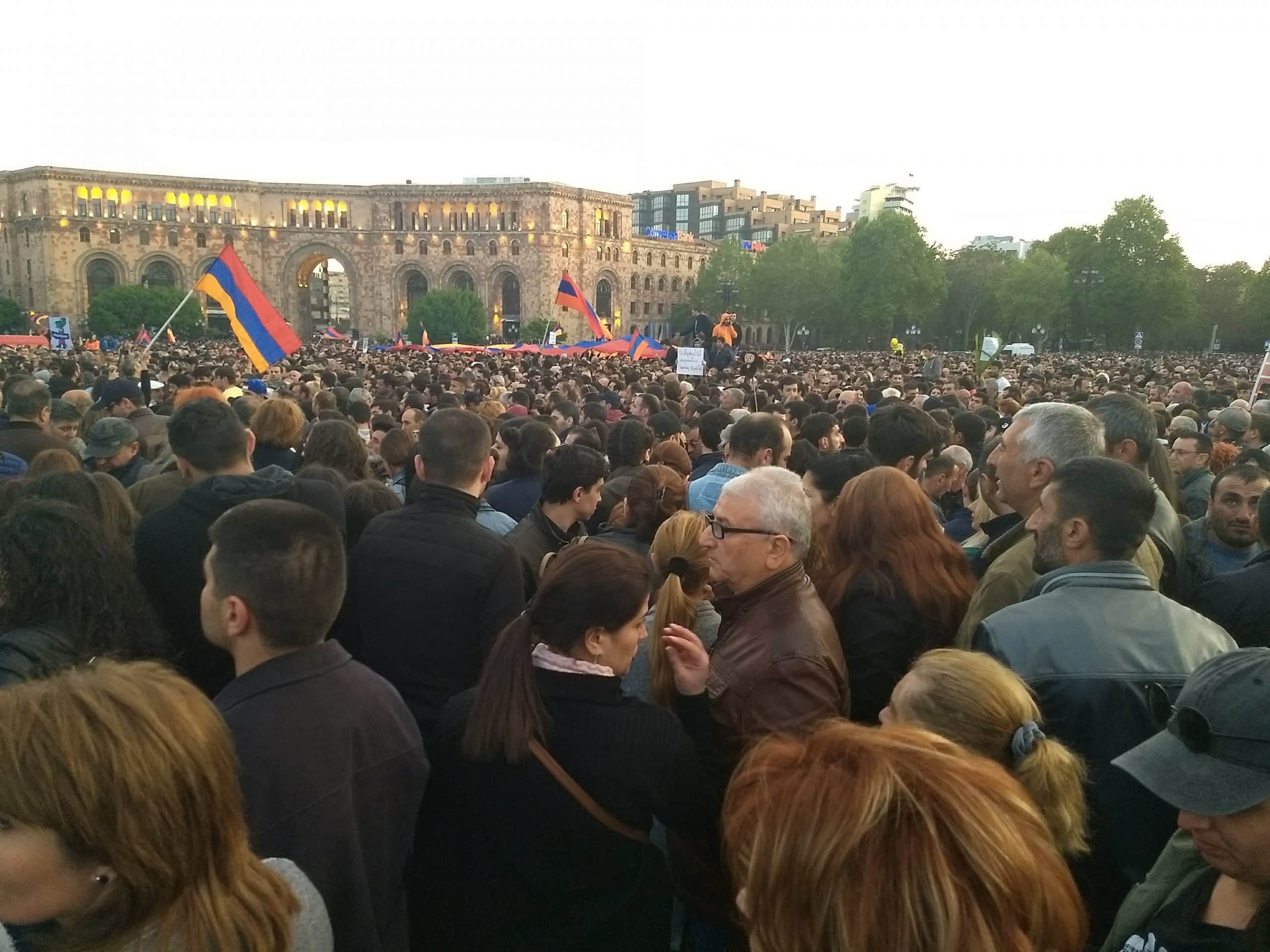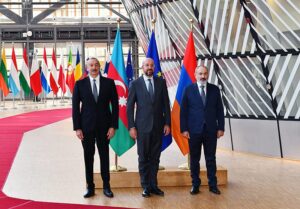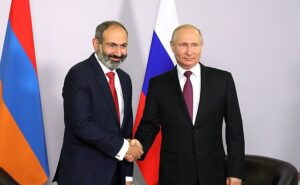On the 11th day of peaceful mass protests in Armenia, PM Serzh Sargsyan resigned, marking a historic event in Armenia and the wider region: a peaceful revolution deposing a leader without a single death or serious injury. After celebrations subside in Yerevan and other cities in Armenia, it will face a daunting task of building a new system of government. This news alert is meant to clarify the events that led to the ousting of Sargsyan, and its immediate aftermath.
The trigger
The protests began on Friday April 13th, when it became clear that Sargsyan’s ruling Republican Party will officially nominate him as its candidate for the post of Prime Minister the next day. With an absolute majority in parliament, there was no doubt he would then be elected. Coalition partner Armenian Revolutionary Federation – Dashnaktutyun supported his candidacy. (Throughout the protests it would call for restraint, rational behaviour, and dialogue.) Sargsyan’s nomination was significant for two reasons. First, in 2015 under the ruling party’s (and his own) initiative the constitution was changed to transfer crucial powers from the President to the PM; those changes would come into force once Sargsyan’s second and final presidential term would end in April 2018. Second, Sargsyan had explicitly pledged not to seek the post of PM. While his nomination was the direct trigger of the protests, it is important to note that they were about more than that: the people in the streets were protesting corruption and nepotism that had only solidified under Sargsyan’s rule, and a lack of perspectives, especially for the youth.
Following the news of Sargsyan’s nomination, opposition leaders called for protests. Most notable was Nikol Pashinyan, MP and one of the leaders of Yelk, an opposition alliance of three parties, with 9 seats in parliament. At the time he was on a walking tour through the cities and towns of Armenia to drum up support for regime change. Upon hearing the news he cut his tour short and rushed back to capital Yerevan, where students of the Yerevan State University had already announced a strike. Joining the students, he led them to a central square, where thousands of people had started to gather. In the following days large crowds gathered in central Yerevan, blocking its streets and intersections. This culminated in a march on parliament on Tuesday, April 17th, when Sargsyan was officially elected as PM in a parliament session, while the crowds faced off with a police cordon outside. At the daily closing rally that evening, Pashinyan proclaimed the start of a velvet revolution, and called for ongoing acts of civil disobedience. He insisted – and kept insisting in following days – to completely restrain from violence, even in the event of violence being used by police. The demands were Sargsyan’s resignation and an interim government that would organize early elections, overseen by a PM put forward “by the people.” In following days the protests grew, with protesters blocking streets, government buildings, and even street crossings. The latter act of civil disobedience gave the name to the “pedestrian” revolution: activists would perform “eternal loops” of slowly walking back and forth on a given street crossing, thereby paralyzing the street and intersection, until police interfered, after which they would move on to another crossing and repeat.
The beginning of the end…
Police struggled to get a grip on the protests, as they were highly decentralized and large groups kept constantly moving around the city. It was also clear that they were hesitant in using violence: apart from a couple of small clashes and some hard-handed arrests there were practically no cases of mass beatings or crackdowns. Many people got arrested, however, – at the peak of the protests there were more than 200 people in jail – but the most would get released within hours or a day or two. Within days the protests had not only spread to the outskirts of Yerevan but also to other cities and towns across the country. On April 19th, now PM Sargsyan in a feeble attempt at a concession offered to give up his official residence, which, predictably, didn’t do anything for the protesters. On April 21st newly elected president Armen Sarkissian (no relation) visited Pashinyan during a rally on Republic Square, where they had a brief exchange. Pashinyan later announced that he would be negotiating with PM Sargsyan about the latter’s resignation the next morning. Those talks did indeed take place on the 22nd, but Sargsyan only attended for 3 minutes: he was piqued about the presence of cameras and journalists, said he had no intention of resigning and made a reference to 1 March 2008, when during mass opposition protests 10 people had died, saying to Pashinyan that he “hadn’t learnt the lesson” of those protests. He also said a man representing about 7-8% of the population (a reference to Yelk’s election result) cannot speak on behalf of a nation. This latter comment and the reference to 2008 caused public outrage. In addition, some 1.5 hours after the talks Pashinyan and most leaders of the protest were arrested.
Instead of demotivating the protesters, this caused a massive outpouring of unprecedented numbers of people into the streets, with students taking over the lead as the politicians were jailed. A huge crowd surrounded the police station where the three MPs from Pashinyan’s party, Civil Contract, were believed to be held. That evening, the daily closing rally was said to have had some 160.000 participants, which is unprecedented in its scale, in a city of 1 million. The next afternoon deputy PM Tigran Karapetian had a meeting with Pashinyan in prison. That afternoon the latter was suddenly released. As he walked out to greet his supporters, he told them to give him a couple of hours to discuss some things with his colleagues, and that he would address the crowd at Republic Square later on. In less than an hour PM Serzh Sargsyan resigned his post through an official letter posted on his website. In the letter, he addressed all groups in society, including the protesters, speaking in lofty terms about the young activists. He concluded the letter by saying:
“Nikol Pashinyan was right. I was wrong. The situation has several solutions, but I will not take any of them. That is not mine. I am leaving office of the country’s leader, of Prime Minister.
The street movement is against my tenure. I am fulfilling your demand.
Peace, harmony and reasoning for our country.
Thank you”
Predictably, the news was followed by mass celebrations on the streets of Yerevan and other cities.
…or the end of the beginning?
As the euphoria and buoyant moods subside, Armenians will face the daunting task of building a new system, or, as some have been calling it, “a new country.” For now, Pashinyan will hold talks with Deputy PM Tigran Karapetyan tomorrow at 11:00 on “the transfer of power to the people”. Parliament is to nominate a candidate for a new PM within a week, and Pashinyan has called for early elections as soon as possible after that. The ruling Republican Party, which still has a majority in parliament, has already announced it will be putting forward a candidate.
Immediately after Sargsyan’s resignation, Pashinyan was already reaching out to Armenians who might feel threatened by the developments, saying “I want to appeal to entrepreneurs who are worried about this political process and … may be packing up to leave the country or remove capital from Armenia,” he said. “Please do not do that because there will be no vendettas, no hatred, no revenge.” He vowed to strive for an “atmosphere of national unity.”
In an interesting turn of events, Reactions by Russian officials have been uncharacteristically restrained or even downright positive. In one telling example, spokesperson for the Russian Ministry of Foreign Affairs, Maria Zakharova, Tweeted: “A people that has the power even in the most difficult times in its history, to not get divided and retain respect towards each other despite categorical differences of opinion – is a great people. Armenia, Russia is always with you!” Such reactions seem to indicate that the Kremlin is not planning to interfere in the events in Armenia, or may even approve of them, which will allow some breathing space for the main political players on the ground. It has also spawned theories that Sargsyan had actually received a nudge from the Kremlin to stop fighting – Moscow not wishing to bet on another losing horse, while the protesters had exhibited no signs of pro-Western sentiments. Pashinyan himself saw Zakharova’s reaction as a positive sign, and expressed hope others in the international community would follow similarly. While geopolitics was never a factor in the protests that led to the revolution, for the future outlook of Armenia’s course it is important to note that the Yelk alliance has always been perceived as a pro-Western group. However, of the three of its leaders, Pashinyan was always the most restrained one when it came to this issue, leaning more towards neutrality.
Talks break down
In an unexpected twist, on the evening of the 23rd it emerged that the talks between Pashinyan and deputy PM Karapetyan set for the next day were suddenly cancelled. Pashinyan stated that he would only be willing to negotiate with the agenda and demands of the revolution:
- Appointment of a “people’s Prime Minister”
- Formation of an interim government
- Early elections
A statement by Karapetyan said Pashinyan had put forward unacceptable demands, also including the format of the negotiations, claiming that Pashinyan had wanted to decide who would be negotiating with him on the government’s side. Pashinyan called on all supporters to return to the city center the next morning and continue the acts of civil disobedience until all demands are met.
As of this writing, large crowds have gathered in central Yerevan again, while the authorities have brought in the special forces and reinforcements. The situation remains tense and volatile.



